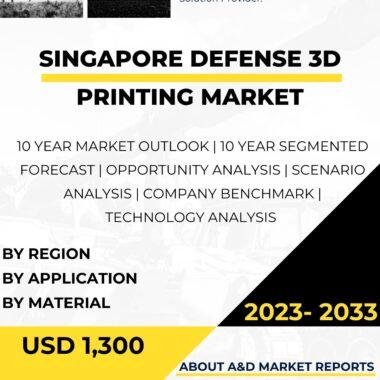Description
Defense 3D printing, also known as additive manufacturing, has emerged as a transformative technology in the United States’ defense industry. This innovative manufacturing process allows for the creation of complex components and structures by building them layer by layer from digital designs. Defense 3D printing offers numerous advantages, including rapid prototyping, customization, reduced lead times, and the ability to create lightweight and durable parts. This article will explore the development, applications, challenges, and significance of defense 3D printing in bolstering the nation’s defense capabilities.
The development of defense 3D printing in the United States can be traced back to the 1980s when the technology was first introduced. Initially used for prototyping and conceptual modeling, 3D printing gradually evolved into a viable manufacturing method for functional parts and components.
In the defense sector, 3D printing found early applications in creating rapid prototypes and models of complex military equipment, such as aircraft components and weapon systems.
As the technology advanced, its capabilities expanded to include various materials, such as plastics, metals, ceramics, and even composite materials.
One of the primary advantages of defense 3D printing is its ability to create intricate geometries and complex structures that are challenging or impossible to achieve using traditional manufacturing methods.
This capability has significant implications for the defense industry, where many military platforms, such as aircraft, naval vessels, and ground vehicles, incorporate highly intricate components to optimize performance and reduce weight.
In aerospace, 3D printing has been instrumental in creating lightweight and durable components for both manned and unmanned aircraft.
The U.S. Air Force and NASA have leveraged 3D printing to produce engine parts, air ducts, brackets, and even entire airframes. The use of 3D-printed components in aerospace applications has led to weight reductions, improved fuel efficiency, and enhanced overall performance.
The U.S. Navy has also embraced defense 3D printing, particularly for shipboard applications.
Additive manufacturing has been utilized to create customized spare parts, repair damaged components, and fabricate unique tools and fixtures onboard ships.
The ability to produce parts on-demand, even in remote or austere environments, reduces the need for extensive supply chains and inventory management, streamlining logistics and maintenance operations.
In the ground vehicle domain, the U.S. Army has explored 3D printing to support its armored vehicle fleet.
By employing 3D printing for producing critical components, the Army can reduce costs, decrease lead times for spare parts, and maintain a higher level of readiness for its armored vehicles.
Moreover, defense 3D printing enables the creation of custom-designed equipment and gear for individual soldiers, optimizing comfort and performance in the field.
Beyond equipment and components, defense 3D printing is revolutionizing the production of munitions and ordnance. The U.S. military has explored using 3D printing to create rocket nozzles, warhead casings, and even small drones.
The ability to rapidly prototype and iterate on new designs for munitions can significantly enhance their performance and effectiveness on the battlefield.
The significance of defense 3D printing lies in its potential to revolutionize the defense industry by disrupting traditional manufacturing practices.
The technology offers the flexibility to produce small quantities of specialized parts and equipment economically, reducing overall procurement costs and promoting innovation.
Additionally, 3D printing enhances the sustainability of defense operations by reducing waste and optimizing resource utilization.
By producing parts on-demand and close to the point of need, the military can minimize excess inventory and decrease its logistical footprint.
The flexibility of defense 3D printing also extends to the customization of equipment for individual warfighters, improving ergonomics and comfort while maintaining mission readiness.
Moreover, defense 3D printing supports strategic independence by reducing dependence on foreign suppliers and ensuring the availability of critical parts and components during times of geopolitical tension or disruption in supply chains.
The technology’s ability to shorten the development and production cycle for new equipment and prototypes enables the rapid fielding of innovative solutions to emerging threats.
To fully realize the potential of defense 3D printing, the U.S. Department of Defense (DoD) and defense contractors are investing in research and development to advance the capabilities of additive manufacturing.
Efforts are underway to explore the use of new materials, including advanced metals, ceramics, and composites, to enhance the strength and performance of 3D-printed components.
Furthermore, the DoD is collaborating with academia and the private sector to develop new 3D printing techniques and optimize the printing process for larger and more complex structures.
As the technology continues to advance, the DoD is also working to ensure the safety and reliability of 3D-printed components through rigorous testing and certification procedures.
Challenges in defense 3D printing include addressing the limitations of current printing methods, such as speed and scale.
While 3D printing excels at producing complex components in small quantities, traditional manufacturing methods may still be more efficient for mass production.
Efforts are ongoing to improve the speed and scalability of 3D printing to enable large-scale production of critical military equipment.
Cybersecurity is another concern, as malicious actors could potentially compromise 3D printing processes or manipulate digital designs to introduce defects or vulnerabilities into printed components.
Ensuring the integrity and security of the digital supply chain is crucial to prevent counterfeit or compromised parts from entering the defense supply chain.
Furthermore, intellectual property protection is a consideration, as 3D printing allows for easy replication of proprietary designs.
To address this issue, the DoD is exploring measures such as watermarking and digital rights management to protect sensitive designs and data.
Moreover, standardization and interoperability are essential to ensure that 3D-printed components can seamlessly integrate with existing defense systems and platforms.




